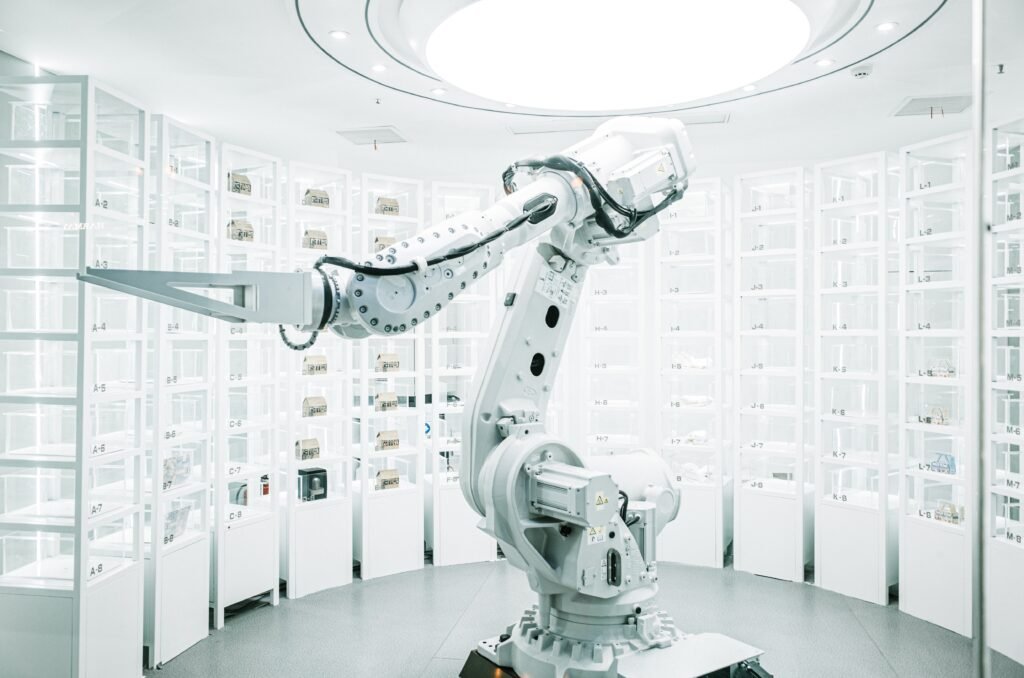Artificial intelligence, a fascinating field that encompasses the development of computer systems capable of performing tasks that would normally require human intelligence, offers a multitude of intriguing subsets to explore. From machine learning and natural language processing to computer vision and expert systems, the possibilities seem endless. Curiosity arises as one wonders, among these various subsets, which one holds the key to unlocking the true potential of artificial intelligence? Let’s embark on a journey to unearth the answer.

Machine Learning
Machine Learning refers to the field of study which focuses on the development of algorithms that enable computers to learn and make predictions or take action based on data. There are different types of Machine Learning techniques, including Supervised Learning, Unsupervised Learning, and Reinforcement Learning.
Supervised Learning
Supervised Learning is a type of Machine Learning where the algorithm is trained on labeled data. In this approach, the algorithm learns from the input and output pairs to predict the output for new, unseen input data. For example, a supervised learning algorithm can be trained on a dataset of images labeled as “cat” or “dog” to be able to classify new images correctly.
Unsupervised Learning
Unsupervised Learning, on the other hand, is a type of Machine Learning where the algorithm learns from unlabeled data. The goal is to find patterns, relationships, or structures within the data without any prior knowledge. This can be useful to discover hidden insights or group similar data together. Common techniques used in unsupervised learning include clustering and dimensionality reduction.
Reinforcement Learning
Reinforcement Learning is a type of Machine Learning where an agent learns to interact with an environment and maximize its rewards. The agent receives feedback in the form of rewards or punishments based on its actions, and its goal is to learn the optimal action to take in order to achieve the highest possible reward. This type of learning is often used in areas such as robotics, gaming, and decision-making problems.
Natural Language Processing
Natural Language Processing (NLP) is a branch of Artificial Intelligence that focuses on the interaction between computers and humans using natural language. NLP techniques enable machines to understand, interpret, and generate human language, enabling tasks such as speech recognition, text-to-speech conversion, and language translation.
Speech Recognition
Speech Recognition is a technology that allows computers to convert spoken language into written text. It involves analyzing audio input and identifying the spoken words or phrases. Speech recognition systems are used in various applications, such as virtual assistants, transcription services, and voice-controlled devices.
Text-to-Speech Conversion
Text-to-Speech (TTS) Conversion is a technology that transforms written text into spoken words. It involves generating human-like speech from the given text, including proper pronunciation, intonation, and emphasis. TTS systems are used in applications such as voice assistants, audiobooks, and accessibility tools for the visually impaired.
Language Translation
Language Translation refers to the task of automatically converting text or speech from one language to another. NLP techniques enable machines to analyze the input text or speech, understand its meaning, and generate an equivalent translation in the target language. Language translation systems are used extensively for cross-language communication, document translation, and localization of software and websites.
Computer Vision
Computer Vision is a field of study that focuses on enabling machines to understand and interpret visual information from images or videos. It involves the development of algorithms and techniques to analyze, process, and extract meaningful information from visual data.
Image Classification
Image Classification is the task of assigning a label or category to an image based on its visual content. Machine learning algorithms are trained on labeled images to learn patterns and features that distinguish different classes. Image classification has numerous applications, including object recognition, medical imaging, and autonomous driving.
Object Detection
Object Detection refers to the task of identifying and localizing objects within images or videos. It involves detecting and classifying multiple objects within a scene. Object detection techniques are widely used in applications such as video surveillance, self-driving cars, and image-based search engines.
Image Segmentation
Image Segmentation is the process of dividing an image into multiple segments or regions based on visual attributes. It aims to identify and separate different objects or regions within an image. Image segmentation is useful for tasks such as image editing, medical imaging analysis, and object tracking in videos.
Expert Systems
Expert Systems are computer systems that mimic the decision-making capabilities of human experts in specific domains. They utilize knowledge and rules to provide advice, make decisions, or solve complex problems.
Rule-based Systems
Rule-based Systems are a type of Expert Systems that use a set of logical rules to make decisions or provide recommendations based on given conditions. These rules are typically in the form of “if-then” statements, where certain conditions trigger specific actions or recommendations. Rule-based systems are often used in domains such as healthcare, finance, and engineering.
Fuzzy Logic Systems
Fuzzy Logic Systems are a type of Expert Systems that deal with imprecise or uncertain information. They use fuzzy sets and fuzzy rules to process data or make decisions based on degrees of truth rather than binary true/false values. Fuzzy logic systems are valuable in applications where precise reasoning is difficult, such as control systems or decision support systems.
Inference Engines
Inference Engines are the components of Expert Systems that perform logical reasoning and deduction based on the rules and facts stored in the knowledge base. They are responsible for drawing conclusions, making inferences, and providing answers or recommendations based on the given inputs. Inference engines are critical for the functioning of expert systems, as they enable intelligent decision-making.

Neural Networks
Neural Networks are a type of machine learning model inspired by biological neural networks in the human brain. They consist of interconnected nodes, or artificial neurons, that process and transmit information. Neural networks have shown remarkable capabilities in solving complex problems and are widely used in various domains.
Artificial Neural Networks
Artificial Neural Networks (ANNs) are the foundation of neural network models. They are composed of interconnected layers of artificial neurons, each performing simple computations. ANNs can be trained on large datasets using algorithms like backpropagation to learn complex patterns and relationships. They have found applications in areas such as image recognition, natural language processing, and recommendation systems.
Convolutional Neural Networks
Convolutional Neural Networks (CNNs) are a specialized type of neural network designed for processing and analyzing visual data, such as images or videos. CNNs use convolutional layers to extract spatial hierarchies of features from the input data, enabling them to recognize complex visual patterns. CNNs are widely used in image recognition, object detection, and image generation tasks.
Recurrent Neural Networks
Recurrent Neural Networks (RNNs) are a type of neural network designed for sequential data processing, such as time series or natural language data. RNNs use feedback connections to preserve and utilize information from previous steps, allowing them to capture dependencies and context over time or sequence. RNNs are used in applications like speech recognition, machine translation, and sentiment analysis.
Robotics
Robotics is a field that deals with the design, construction, and operation of robots. Robotics combines principles from various disciplines, including computer science, engineering, and artificial intelligence. The goal is to develop intelligent machines capable of performing tasks and interacting with the physical world.
Motion Planning
Motion Planning refers to the process of designing a path or trajectory for a robot to move from one point to another while avoiding obstacles. It involves algorithms that take into account the robot’s kinematics, environment, and constraints to generate collision-free and efficient paths. Motion planning is crucial for autonomous robots, industrial automation, and robot navigation.
Object Manipulation
Object Manipulation involves designing algorithms and techniques for robots to interact with objects in their environment. This includes tasks such as grasping, picking, and manipulating objects with precision and reliability. Object manipulation is essential for tasks like warehouse automation, assembly line robots, and healthcare robotics.
Human-Robot Interaction
Human-Robot Interaction (HRI) focuses on enabling seamless and intuitive communication between humans and robots. It involves designing interfaces, algorithms, and systems that allow humans to interact with robots using natural language, gestures, or other modalities. HRI is critical for applications such as social robots, healthcare assistance, and collaborative robots in industry.

Knowledge Representation and Reasoning
Knowledge Representation and Reasoning (KRR) is a field that deals with representing knowledge in a structured and meaningful way, and reasoning or inferring new knowledge from existing knowledge. KRR techniques enable machines to store, organize, and utilize knowledge for intelligent decision-making.
Ontologies
Ontologies are formal representations of knowledge that capture the concepts, relationships, and properties within a specific domain. They provide a shared vocabulary and structure for representing knowledge in a standardized and machine-readable format. Ontologies are widely used in semantic web applications, information retrieval, and knowledge-based systems.
Semantic Web
The Semantic Web is an extension of the World Wide Web that aims to enable machines to understand and process the content of web pages. It involves adding semantic metadata to web resources, allowing machines to interpret and reason about the data. The Semantic Web enables advanced search capabilities, intelligent information integration, and automated reasoning.
Symbolic Reasoning
Symbolic Reasoning refers to the process of using symbols and rules to perform logical calculations or deductions. It involves manipulating symbolic representations of knowledge and applying logical rules to derive new knowledge. Symbolic reasoning is employed in expert systems, automated theorem proving, and logic programming.
Cognitive Computing
Cognitive Computing is an interdisciplinary field that combines principles from artificial intelligence, psychology, neuroscience, and linguistics. It focuses on building computer systems that can mimic human cognitive abilities such as perception, reasoning, learning, and problem-solving.
Pattern Recognition
Pattern Recognition is the ability to identify and interpret meaningful patterns and structures within data. Cognitive computing techniques enable machines to automatically recognize patterns from different types of data, such as images, text, or time series. Pattern recognition has applications in areas such as image analysis, handwriting recognition, and anomaly detection.
Natural Language Understanding
Natural Language Understanding (NLU) is the ability of machines to comprehend and interpret human language. NLU techniques enable machines to analyze the structure, meaning, and context of natural language text or speech. NLU is crucial for applications such as virtual assistants, chatbots, and sentiment analysis.
Decision Making
Decision Making refers to the process of selecting the best course of action among multiple alternatives based on available information and goals. Cognitive computing systems utilize techniques such as machine learning, probabilistic reasoning, and expert systems to make intelligent and informed decisions. Decision making is valuable in applications such as automated diagnosis, resource allocation, and financial forecasting.
Deep Learning
Deep Learning is a subfield of machine learning that focuses on training artificial neural networks with multiple layers, often referred to as deep neural networks. Deep learning has revolutionized many areas of artificial intelligence by enabling models to automatically learn hierarchical representations and complex patterns from massive amounts of data.
Deep Neural Networks
Deep Neural Networks (DNNs) are neural networks with multiple hidden layers, enabling them to learn hierarchical representations of data. Deep learning models, such as deep convolutional neural networks and deep recurrent neural networks, have shown remarkable performance in areas such as image recognition, speech recognition, and natural language processing.
Generative Adversarial Networks
Generative Adversarial Networks (GANs) are a type of neural network architecture that consists of two components: a generator and a discriminator. GANs are used for generating new data that resembles a given training dataset. They have been successful in generating realistic images, synthesizing videos, and creating believable text or speech.
Recurrent Neural Networks
Recurrent Neural Networks (RNNs), as mentioned earlier, are neural networks that are designed to process sequential data. They have been widely used in natural language processing tasks, such as language modeling, machine translation, and sentiment analysis. RNNs can capture long-term dependencies and context within sequential data, making them powerful for time-series prediction and sequence generation.
In conclusion, artificial intelligence encompasses a wide range of subfields and techniques. Machine Learning, Natural Language Processing, Computer Vision, Expert Systems, Neural Networks, Robotics, Knowledge Representation and Reasoning, Cognitive Computing, and Deep Learning all contribute to the advancement of AI and enable machines to perform complex tasks and emulate human-like intelligence. These developments have the potential to revolutionize industries, improve efficiency, and enhance our everyday lives.






